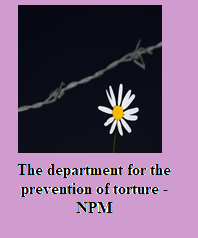
THE DEPARTMENT FOR THE PREVENTION OF TORTURE
AND OTHER CRUEL, INHUMAN OR DEGRADING
TREATMENT OR PUNISHMENT OR IN PLACES OF DETENTION
– NPM –
By ratifying the Optional Protocol to the Convention against Torture (OPCAT), adopted by the United Nations General Assembly on 18 December 2002, Romania undertook to set up a body to visit places of detention, in order to prevent torture and other cruel, inhuman or degrading treatment or punishment in places of detention.
Starting with 2014, within the People’s Advocate institution functions the National Preventive Mechanism (NPM).
What is the mission of the NPM?
NPM regularly monitors the treatment of persons in detention, with the aim of:
- strengthening the protection of persons deprived of their liberty against:
- torture
- inhuman or degrading treatment or punishment
- non-discriminatory exercise of fundamental rights and freedoms
What does a place of detention and deprivation of liberty mean?
Place of detention means any place where persons are or may be deprived of their liberty, either on the basis of an order of a public authority or at its request or with its tacit consent.
Deprivation of liberty means any form of detention or imprisonment or the placement of a person in a public or private place which they cannot leave at will, by order of any judicial, administrative or other authority, including by decisions of private legal entities that administer social services.
What are the places considered as places of detention?
The People’s Advocate Institution exercises its duties regarding the prevention of torture and other cruel, inhuman or degrading treatment in:
- penitentiaries, including prison-hospitals
- educational centers, detention centers
- police detention and remand centers
- residential services for minors who have committed criminal acts and are not criminally liable
- psychiatric hospitals for safety measures, psychiatric hospitals
- transit centers
- accommodation centers for foreigners taken into public custody, subordinated to the General Inspectorate for Immigration
- special reception and accommodation centers for asylum seekers, subordinated to the General Inspectorate for Immigration
- closed care centers for drug users
- any other place that meets the conditions of a place of detention
- any other place that is part of the health system or social assistance system that the person cannot leave at will
Regarding the area of competence of the NPM:
OPCAT requires that the NPM have access to any other place where someone may be kept against their will in connection, even indirectly, with public authority.
and
The UN Subcommittee on Prevention of Torture (SPT) states that any place where a person is or may be deprived of their liberty should be covered by the OPCAT mandate if there is a situation in which the State exercises, or could exercise, a regulatory function.
The SPT also states that official quarantine places fall within the OPCAT mandate and it is inexorable that all other places from which persons are prevented from leaving for similar purposes fall within the scope of the mandate of the OPCAT and thus within the sphere of oversight of national preventive mechanisms established within the framework of the OPCAT.
How does NPM work?
- by carrying out announced or unannounced VISITS in places of detention;
- by formulating RECOMMENDATIONS to the management of the places visited, in cases where irregularities are found;
- by formulating PROPOSALS for amending and supplementing the legislation in the field of torture prevention or comments on existing legislative initiatives in the field;
- by organizing information, education and training campaigns in order to prevent torture and inhuman or degrading treatment and punishment;
- by liaising with SPT.
How are NPM visits conducted?
- NPM can visit at any time, any place where people are deprived of their liberty
- NPM is free to choose the places they want to visit and the persons they want to meet
- NPM has access to:
- all information regarding the number of persons deprived of their liberty in places of detention, as well as the number of these places and their location
- all information regarding the treatment applied to those persons, as well as the conditions of detention
- all places of detention and their installations and facilities
- NPM has meetings with the management of the place of detention, with staff members, with persons deprived of liberty, as well as with any person who can provide pertinent information
- Meetings with persons deprived of their liberty shall be held without witnesses, either in person or with an interpreter, if deemed necessary.
- No person can be held responsible for the information communicated to the members of the visiting team.
What is the composition of the visiting team?
The visiting team is multidisciplinary and consists of: legal experts, doctors, psychologists, social workers and representatives of non-governmental organizations.
What happens after the visit?
- A Visit Report is drawn up which, in cases where irregularities are found, is accompanied by reasoned Recommendations to improve the treatment applied and the conditions provided to persons deprived of their liberty and to prevent torture and other inhuman or degrading treatment or punishment.
- In cases where there is a violation of human rights through torture or other ill-treatment that poses an imminent risk of harm to the life or health of a person, a Preliminary Emergency Report is prepared.
- When there are indications regarding the commission of criminal acts, the judicial bodies are notified.
- The implementation of the Recommendations is pursued by: maintaining a continuous dialogue with the visited unit, subsequent visits, notifying the hierarchically superior authorities (if the visited unit does not comply).
- The visit reports and the answers of the visited units and of the hierarchically superior authorities, as the case may be, are public and are posted on the website of the People’s Advocate institution.